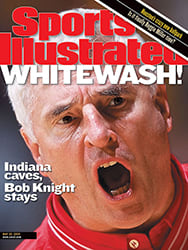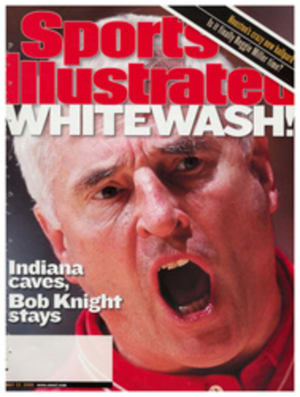
Shanks For The Memories How do you find a cure for the spookiest shot in golf? Forgetaboutit!
In the first tournament of Rex Caldwell's Tour career, the 1975
Phoenix Open, the wide-eyed rookie distinguished himself by
shanking three attempted chips to the 4th green at Phoenix
Country Club. "The third one got on the green," says Caldwell,
"but it wasn't headed anywhere near the hole. I made like a
25-footer for a double."
Later that season, in the second round of the Houston Open at
Woodlands Country Club, Caldwell, dubbed Sexy Rexy for his
mustache and exquisitely coiffed 'do, shanked the ball four
times in the first nine holes. On the 10th he split the fairway
and left himself with an approach of 80 yards. "I told the guys
to stop walking ahead of me," Caldwell says. "I proceeded to
shank a wedge right over their heads. I was proficient at it. I
could tell when it was coming."
Caldwell, who won once on Tour, is not the biggest name to
become eligible for the Senior tour this season--he turned 50 on
May 5--but he is most likely the only chronic shanker. He's
proof that even the best players in the world aren't immune to
golf's most crippling, beguiling shot--one that is so
fantastically awful that its appearances at the professional
level are the height of incongruity and, consequently, hilarity.
A shank is a ball that goes sideways. It's what results when the
ball meets the hosel, the part of a club that connects the shaft
to the head. Baseball players inexplicably lose the ability to
throw, tennis players get the service yips, and basketball
players are buffaloed by the free throw. Golfers shank.
Jack Nicklaus was playing in the 1964 Masters, with Arnold
Palmer in command of the tournament, when he got to the 12th
hole on Sunday. As Nicklaus waited to hit, he noticed the
cofounders of Augusta National, Bobby Jones and Clifford
Roberts, sitting in a cart in front and to the right of the tee.
"I was standing there with an eight-iron in my hands," Nicklaus
says. "The pin was back right. I'll never forget the tension in
my right arm. I've never felt anything like it. When I swung, my
right arm just dominated; it never broke down. I shanked it
right over their heads. It went so far right it didn't even go
in the water. But it was a very pretty shank--one of the best I
ever hit. I usually don't remember bad shots, but I couldn't
forget that one."
Who knows around which corner the shank lurks? So mysterious is
the shot, many players won't utter the S word, instead using
such euphemisms as the lateral or pitchout. "It's an airborne
virus," says CBS commentator Gary McCord. "If you say it, you
might catch it."
At the '72 Bing Crosby National Pro-Am, Johnny Miller was on the
downhill par-4 16th hole at Pebble Beach, tied with Nicklaus.
Everybody thought the 32-year-old Golden Bear, with 36
victories, would devour the brash, 24-year-old Miller, but
that's not what happened. The shank devoured Miller. After a
perfect drive Miller sized up his approach shot and, using a
seven-iron, hit what he later called "the perfect shank." He
bogeyed the hole, lost in a playoff and left Monterey a changed
man. A year later, when Miller won the U.S. Open at Oakmont, he
played the inward half of his final-round 63 with one swing
thought: Don't shank it. "It was haunting," Miller says. "You
never forget it. After the Crosby I never won another tournament
without it playing on my mind down the stretch."
The shank is only one stroke, but it's not that simple. "Once
you've done it," McCord says, "the next shot is always really
interesting. It's usually a pull-hook."
Or another shank. If the first shank is followed by a second,
you've got the shanks, you're in deep, and while they would
never say it, your playing partners would just as soon you were
quarantined. Bruce Devlin of Australia, who won nine times on
Tour, will shank on purpose at exhibitions, just to make people
squirm. "After the second one they know I'm doing it on
purpose," he says, "but it shakes up everybody to start with."
Like a high-speed car crash, a shank is both grotesque and
strangely fascinating. During a practice round for the '70
Westchester Classic, Ben Hogan joined an obscure pro named Hal
Underwood and another player on the back nine. Underwood watched
in awe as the vaunted Hogan eagled the par-5 12th hole, but at
the par-3 16th Hogan shanked his tee shot. The ball rattled
around the TV tower behind the 15th green before coming to rest.
Underwood froze. Should he get the ball? Should he say anything?
Hogan teed up another one and hit it flush this time, and the
three pros walked to the green. "By the way he acted," Underwood
said, after leaving the ball alone, "he had me convinced that
the first shot never happened."
One of Dottie Pepper's dogs was named Shank. That meant puppy
training at Pepper's place--"Heel, Shank! Heel,
Shank!"--mirrored the play-by-play of Caldwell's early career. A
few years after his rookie season Sexy Rexy was in Philadelphia
for the IVB Classic. Standing on the tee of the 128-yard par-3
9th hole, he started feeling uneasy. "It was a real narrow tee
box, and they let the people right down the line," he recalls.
"This one guy was leaning over the ropes a little bit." Hoping
his premonition was wrong, Caldwell swung and hit "a knockdown
eight-iron shank" that struck the man in the forehead and
skipped out-of-bounds. "Rex didn't say a word," says McCord. "He
went over and looked at the guy, waited for some people to show
up and then walked in."
"I wasn't going to hit another one," says Caldwell. "I would
have scared those people to death. Besides, I wasn't going to
make the cut anyway.
"Those were the days when my swing was real upright," he says.
"If you've got a real upright swing, you're more prone to
shanking than you are with a flat swing."
That's open to debate. Phil Rogers, a former Tour player and now
a well-respected teaching pro, says, "It's more of an advanced
player thing. Your very best players miss their shots toward the
heel when they don't hit it solid."
Not that ordinary players don't shank. During a round with SI's
Rick Reilly in '95, President Clinton shanked a wedge and
moaned, "Now, what'd I do there?" Excellent question. Among the
theories:
Rogers: "It's a function of the swing. If you come in with an
open face, you're going to hit a lot of shanks."
Devlin: "It comes from not completing the backswing and moving
forward past the ball. The combination puts the club outside the
plane, causing shanks."
McCord: "Guys who have a lot of upper-body slide, who work the
heel through first, like Paul Azinger, are susceptible."
Devlin says he once contracted the shanks through a shoulder
injury, which seems plausible in light of the fact that Greg
Norman, in his first day back from shoulder surgery in 1998, hit
a shank for the first time in 10 years. As Nicklaus's story
suggests, in most cases the miscue is caused by pressure. Mark
Calcavecchia hit a half-shanked two-iron during his famous
meltdown at the '91 Ryder Cup. Amy Alcott was just two wins shy
of the LPGA Hall of Fame and in contention at the '90 Rochester
International when she shanked a shot and lost. "It's
embarrassing when you do it out there in front of God and
everybody," Alcott says. "You've got all the gallery watching,
and you're yelling 'Fore!' and you're 50 yards right of the
green. At that point it's a game from hell."
Caldwell controlled his shanks by using offset clubs, but he was
never really cured. Once, on the range at Oak Hills Country
Club, then the home of the Texas Open, he asked if he might try
hitting one of Woody Blackburn's forged irons. As Caldwell took
hold of the club, Bill Kratzert yelled, "Fore right!"
"You know in the movie Tin Cup when Roy McAvoy's on the range
and he hits it sideways? That's what happened," Caldwell says.
"It went straight across in front of everybody. I gave Woody
back his club and said to Kratzert, 'I knew that.'"
To pay the bills in his early days, Caldwell caddied and took
small loans from friends, among them a Memphis dentist who felt
a certain kinship with Caldwell. They were both shankers. Yet
Caldwell, who won the LaJet Classic in Abilene, Texas, in '83,
when he finished a career-high sixth on the money list, is
mostly indebted to Karsten Solheim, whose Pings were the first
offset clubs. "Pings weren't fashionable back then," Caldwell
says, "but I had to do something if I was going to stay on Tour."
There are other cures. Jerry Barber designed shank-proof Golden
Touch irons, which feature a flat hosel so that the ball will
come off straight if it's hit there. Golden Touch irons are hard
to find, but Tom Barber, one of Jerry's two sons, will sell you
a set at Griffith Park Golf Course in Los Angeles, where he's
the head pro. Rogers recommends that when you practice, you lay
a two-by-four outside the ball and make sure your swing path
stays inside the board. Devlin says you've got to get a good
shoulder turn behind the ball.
Caldwell's shanks come back on occasion. He was playing in the
third round of the Nike Central Georgia Open in Macon in '95 and
was eight under par for the day, 16 under for the tournament.
When he looked at a leader board behind the 14th green, he
noticed that he had lost ground on the day. "I was thinking,
S---, what do I have to do to win out here? I teed it up
and--boing!--dead-shanked a two-iron right into the boonies," he
says. "It really pissed me off. I had to hit another one. Trust
me, I was nervous hitting that second one. I know me."
Caldwell says some of his fellow pros insist they've never
shanked. How can this be, he asks? Guys like Scott Hoch and
Vijay Singh have perfect swings for the shank. Steep, upright
and right on top of the ball.
"You get a little bit inside out and a little tight, and you
never release the club," Caldwell says, beginning to get
excited. "We're only talking about a half-inch between the hosel
and the center of the club face, and the swing is moving at 100
miles an hour! Why wouldn't you hit a shank?"
Fore right, Senior tour. Sexy Rexy isn't done yet.
THREE COLOR ILLUSTRATIONS: ILLUSTRATIONS BY CHRIS PYLE
Nicklaus will never forget his mishap at the Masters. "It was a
very pretty shank," he says, "one of the best I ever hit."
Miller says that after his shank at the Crosby, "I never won
another tournament without it playing on my mind."

